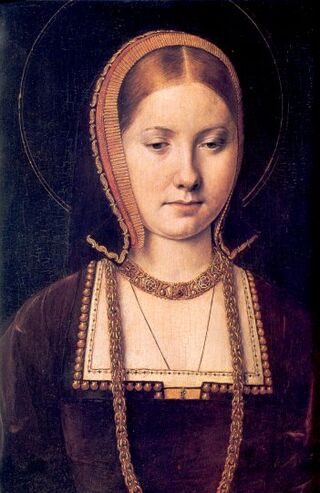Narcissism
Long Live the Spanish Princess
Catherine of Aragon was Henry VIII's first victim of marital narcissism.
Posted October 11, 2020 Reviewed by Ekua Hagan

Part 2 of Henry's Greats: Marital Narcissism of Henry VIII. Click here for Part 1: The King of Narcissism.
The first and second seasons of The Spanish Princess are currently streaming on the Starz platform. The show brings attention to one of the most important and sometimes undermined figures of the Tudor monarchy.
The Spanish Princess is loosely based on the years Catherine of Aragon spent in England, first as Prince Arthur’s bride and subsequent widow, and then as King Henry VIII’s wife. Catherine was many things in her life—mother, benefactor, a royal princess in her own right—but ironically became known as just one of the six victims of Henry’s marital narcissism.
Historically, royal matches were calculated to result in an influx of power and authority. Marriages were almost always made for the good of the realm with no concern of love or compatibility; partners were carefully chosen based on alliances and necessity. The ascension of Henry VIII was critical due to several reasons, the most imperative being the infancy of the Tudor reign. Henry VIII’s narcissism may have become notoriously feared in his later years on the throne, but it was a pivotal reason behind his choices of brides, beginning with Catherine of Aragon.
Like most narcissists, Henry was enamored with the theory of romantic love but couldn’t actually experience it. Too many contrasting factors would block his ability to embrace the vulnerability that comes with love: his notorious anger and competitive streak; the jealousy that punctuated his marriages and affairs; unending and perhaps unrealistic demands for the best of everything; and, ultimately, his obsessive desire for a male heir.
Undisputed Royalty
Catherine of Aragon was the youngest daughter born to two of the most powerful monarchs in the world: Isabella of Castile and Ferdinand of Aragon. The marriage of Isabella and Ferdinand united Spain and, through their ruling, empowered it to become an intimidating display of wealth, religion, and supremacy. At 3 years old, Catherine was betrothed to Arthur, Prince of Wales, and thus was referred to as the future Queen of England. Henry, on the other hand, was nothing more than a second son destined for a career in the Church. It was only upon the death of his brother that Henry became indisputably necessary to the Tudor monarchy.
Isabella and Ferdinand were both monarchs from long, established lines of royalty. In fact, Catherine had more legitimate noble blood than even Henry VII himself. Like Henry VII, Catherine was descended from the House of Lancaster; however, unlike Henry, Catherine’s bloodline was legitimate. It was the willingness of the Spanish monarchs to marry the infanta to Arthur that validated the Tudor’s recognizance in the eyes of royal Europe.
It is quite possible that, behind the proclamations of love, Henry harbored deep jealousy over Catherine of Aragon. Unlike himself, Catherine was born to established monarchs and was called “The Queen of England” while still in the cradle. Henry, on the other hand, was the second son of a usurper. Styled the Duke of York, he was never expected to become king, whereas Catherine was taught it was her destiny to rule England.
Narcissists have a problem with jealousy: Not only do they believe people are jealous of them, but they are jealous of other people. Henry very well could have resented Catherine for her undisputed royal rank while harboring his own insecurities and shame.
The Fulfillment of a Fantasy
Upon Arthur’s sudden death in 1502, when it became clear that Catherine was not pregnant, Catherine swiftly fell from royal favor. Her father and Henry VII were in a standoff regarding her dowry payment, and so the widow was essentially a nobody. Henry VII was a known penny-pincher, and he hated the idea of returning her dowry. In exchange, it was suggested that Catherine would instead marry the new heir, Henry.
However, due to her father’s stubbornness and Henry VII’s stinginess, Catherine ended up practically a penniless afterthought. The former future Queen was now reduced to selling her possessions, patching her one-elaborate gowns, and begging her father for money to pay her servants. Her engagement to Henry was ignored.
Henry, Duke of York, became King Henry VIII when his father died in April 1509. In May, Henry announced that he would marry Catherine, essentially plucking her from her pitiful life and elevating her to that of a Queen. They were married on June 11, 1509, and 23-year-old Catherine of Aragon was crowned and anointed the Queen of England on June 23.
Henry was known for his love of poetry, music, and pageantry. He was a passionate participant in masques and jousting and styled himself “Sir Loyal Heart,” dutifully earning the favor of his Queen and love. Narcissists are blinded by fantasies of wealth, power, and recognition; in Henry’s fantasy, he played the part of the white knight who saved the suffering Princess.
The Collapse of a Dream
Unfortunately, the fantasy Henry constructed was without firm footing. The marriage and line of succession should have gone according to plan or, in Henry’s case, according to fantasy. Thus, in return for saving her, Catherine should have been able to give Henry sons. Sadly, this was not the case for Queen Catherine.
In 1510, Catherine suffered her first miscarriage of a girl. Four months later, in May 1510, a second pregnancy was announced. On January 1, 1511, she delivered a healthy baby, Henry, Duke of Cornwall, to great fanfare and the relief of the court. The infant prince died suddenly just 52 days later. The years 1513 and 1514 saw two more premature deaths: a stillborn boy and a short-lived boy.
Catherine was able to carry her next pregnancy to term, resulting in the birth of a healthy girl. Although the pregnancy was not held in high hopes of success, the child thrived and would be named Mary. Henry, true to his narcissistic and kingly nature, was disappointed. This little girl who would grow up in her father’s shadow and be subjected to his emotional abuse would become Queen Mary I.
Following Mary’s birth, Catherine did not announce another pregnancy until 1518; another girl was born weak and died soon after birth. The failure to deliver a male heir would sit, unfairly, on Catherine’s shoulders. Granted, during this time, it was not scientifically known that the man’s sperm is responsible for the sex of the fetus. Regardless, this apparent failure was the first cause of the breakdown of the once-happy marriage of Henry and Catherine. Henry considered it to be a direct rebuke from God that He was unhappy with Henry and his marriage to Catherine. Catherine would—and could—no longer fulfill Henry’s obsessive, narcissistic fantasy.
Catherine’s slow but steady fall from grace began emphasizing Henry’s cruelty and coldness. Henry had embarked on extramarital affairs before, but the turning point was his obsessive love of Anne Boleyn. By that time, Henry had become convinced that his marriage to Catherine was null and void due to her marriage to his older brother and possible consummation. Catherine was a devout Catholic and swore until her death that she and Arthur had never consummated the marriage, thereby rendering it invalid and leaving her free to have married Henry.
Henry was infuriated by Catherine’s staunch opposition to divorce and refusal to style herself anything less than the Queen of England. In retaliation, Henry kept Catherine separated from their daughter Mary, and the mother and daughter never saw each other again. Henry was convinced that Catherine and Mary would attempt to plot against him, showcasing another narcissistic trait. Absolutely no proof, then or now, exists of treason or a plot between the mother and daughter against their sovereign.

To shatter her spirit, Catherine was moved from decrepit castle to decrepit castle. She signed her name as Catherine, the Queen of England, until her last days. Henry’s neglect, irrational anger, and humiliation at being bested by a woman enhanced his narcissistic and tyrannical traits.
Catherine of Aragon, Queen of England and infanta of Spain, died in the early morning hours of January 7, 1536. As a final blow to belittle the woman that was his superior in many ways, Henry ordered Catherine to be buried as a Dowager Princess and not a Queen. Conceitful and boastful, Henry could not fathom that a woman could ever be his equal. Although this was a standard belief of the time period, it can be theorized that Henry simply could not squelch his jealousy. Catherine of Aragon was born to be Queen of England, was raised and coronated as a Queen, and died as a Queen, if not in name, then by earnings.




